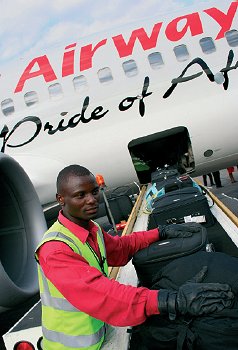Despite a wide geographical area, large population and limited surface transport, progress towards liberalisation of the skies over southern Africa is still painfully slow Southern Africa’s economic growth and job creation could be significantly higher if governments were to lift their limits on airline flights between their countries. This is the conclusion of a headline report by Anton Richman and Chris Lyle, The Economic Benefits of Liberalising Air Transport – A Review of Global Experience. This report was commissioned by the ComMark Trust – a non-governmental organisation working to alleviate poverty in the Southern African region – to explore the cost to economic growth of the highly regulated air transport industry within the 14 members of the Southern African Development Community (SADC), and between SADC and other African countries.
Southern Africa’s economic growth and job creation could be significantly higher if governments were to lift their limits on airline flights between their countries. This is the conclusion of a headline report by Anton Richman and Chris Lyle, The Economic Benefits of Liberalising Air Transport – A Review of Global Experience. This report was commissioned by the ComMark Trust – a non-governmental organisation working to alleviate poverty in the Southern African region – to explore the cost to economic growth of the highly regulated air transport industry within the 14 members of the Southern African Development Community (SADC), and between SADC and other African countries.
The report points out that air travel within South Africa has “surged in the 10 years since the liberalisation of the domestic market”, contrasting this with constrained routes between SADC countries, where prices are high and growth restricted. Quoting an example of the bilateral between Angola and South Africa, which allows only one airline from each country to fly the route just three times a week, the report says that it can be “as expensive to fly from Johannesburg to Luanda, as from Johannesburg to London, three times the distance. While intended to protect the smaller national airlines, the air service restrictions encourage inefficiency, distort the market for potential investors and deprive the country of tourism and business spend.”
The report’s co-author Chris Lyle, team leader of Air Transport Economics, observes: “Bilaterals are strangling attempts at liberalisation, together with vested interests and worry that the weaker national airlines would be swept aside by the likes of South African Airways and the few stronger carriers elsewhere.” Lyle, who previously worked for ICAO and the United Nation’s Economic Commission for Africa (ECA), suggests there are two ways to overcome these fears: to “allow mergers or alliances between airlines to achieve economies of scale, and to enforce rules to prevent unfair competition”.
Lyle is optimistic that co-operation on other issues among SADC and other economic blocs, especially on safety, may help.
Brian Davies, chief executive of UK-based Ashurst Aviation, a consultancy specialising in air transport in developing nations, says: “The majority of airlines are still controlled by governments, whose priority is to protect their national airlines, rather than take a broader view of the economic benefits from liberalisation,” and adds that there is also “a natural fear about foreign domination, but that airlines have to use foreign partners to raise their game”. Davies cites the new Ghana International Airways, Kenya Airways and Virgin Nigeria as examples where this is taking place.
The lack of progress to date and the continued unwillingness of most African governments to implement the Yamoussoukro Declaration, which African civil aviation ministers first signed up to in 1988, was highlighted again at a meeting in Sun City in May 2005. Here ministers failed to agree a timetable for implementation, while expressing concern with the “inordinate delay in the implementation of the Yamoussoukro Decision [on the Declaration]” and reaffirming the “need for the full implementation by all state parties”.
However, a chink of light was provided by an endorsement to establish the African Air Transport Executing Agency under the auspices of the African Union, and by an agreement to strengthen and clarify the role of the Air Transport Monitoring Body, created by the Yamoussoukro Decision. Another positive sign was an agreement last July by the East African Community, an intergovernmental organisation of Kenya, Tanzania and Uganda, to harmonise aviation regulations and fully liberalise air transport between the three countries. Other regional blocs such as the 20-member COMESA (Common Market for Eastern and Southern Africa) and ECOWAS (Economic Community of West African States) have made some progress in trade between their member countries.
Good intentions and frequent agreements tend to mask the crippling inertia blighting a continent of great potential. A wide geographical area, large population and limited surface transport should create significant opportunities for growth of air transport in Africa. But Tewolde Gebre Mariam, executive officer marketing and sales of Ethiopian Airlines, said at the recent African Airlines Association general assembly: “Rising fuel costs, political instabilities, conflicts, terror, poverty and lack of modern infrastructure will slow the pace.”
Some, like Kenya Airways chief executive Titus Naikuni, do not believe it will ever happen on an Africa-wide basis. ■
GUNTER ENDRES / LONDON
Source: Airline Business
















